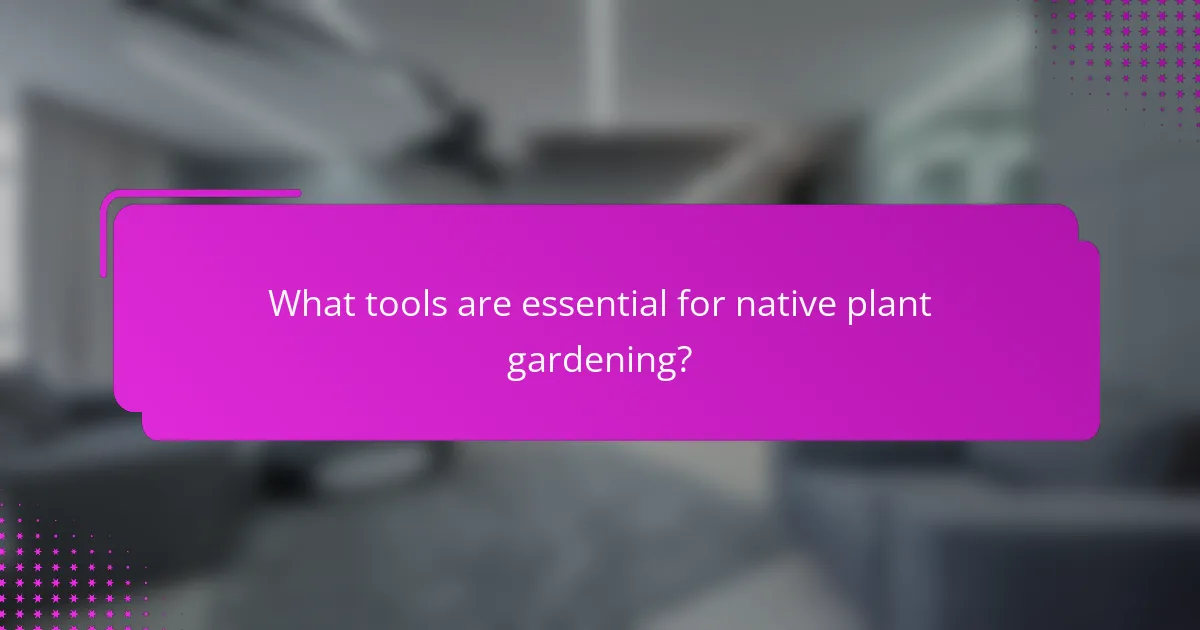Creating a native plant garden is a rewarding way to enhance your landscape while supporting local ecosystems. By choosing plants that are well-suited to your region’s climate and soil, you can promote biodiversity, reduce water usage, and minimize maintenance efforts. These gardens not only beautify your space but also provide essential habitats for wildlife and contribute to environmental sustainability.

How to design a native plant garden in California?
Designing a native plant garden in California involves selecting plants that thrive in the local climate and soil conditions while promoting biodiversity. This approach not only enhances the beauty of your landscape but also supports local wildlife and reduces water usage.
Site selection and preparation
Choosing the right site for your native plant garden is crucial. Look for areas with good sunlight exposure and well-drained soil, as most native plants prefer these conditions. Clear the site of invasive species and debris to create a healthy environment for your new plants.
Consider the existing landscape features, such as trees and slopes, which can affect sunlight and moisture levels. Soil testing can also help determine any amendments needed to support native plant growth.
Choosing native plant species
Selecting the right native plant species is essential for a thriving garden. Focus on plants that are native to your specific region within California, as they are adapted to local conditions. Resources like the California Native Plant Society can provide lists of suitable species.
Consider a mix of perennials, shrubs, and grasses to create a diverse ecosystem. Aim for a variety of bloom times to ensure continuous color and attract different pollinators throughout the growing season.
Design layout and aesthetics
When designing the layout of your native plant garden, think about the overall aesthetics and functionality. Group plants with similar water and sunlight needs together to create a cohesive look. Use natural shapes and curves to mimic the local landscape.
Incorporate layers by placing taller plants at the back and shorter ones in front, which adds depth and visual interest. Consider seasonal changes in color and texture to keep the garden appealing year-round.
Incorporating hardscapes
Hardscapes can enhance the functionality and beauty of your native plant garden. Consider adding pathways, seating areas, or decorative stones that complement the natural environment. Use permeable materials to allow water to infiltrate the soil and reduce runoff.
Integrating features like birdbaths or small ponds can attract wildlife, further enriching the ecosystem. Ensure that any hardscape elements align with the overall design and do not overshadow the native plants.
Water management strategies
Effective water management is vital for a successful native plant garden, especially in California’s dry climate. Implementing drip irrigation or soaker hoses can provide efficient watering while minimizing waste. Mulching around plants helps retain soil moisture and suppress weeds.
Consider rainwater harvesting systems to collect runoff from roofs or paved areas, which can be used to irrigate your garden. Grouping plants with similar water needs can further optimize your watering strategy and promote healthy growth.

What are the benefits of native plant gardens?
Native plant gardens offer numerous advantages, including enhanced biodiversity, reduced maintenance, and improved soil health. By using plants that are indigenous to the area, these gardens contribute to environmental sustainability and support local ecosystems.
Environmental sustainability
Native plant gardens promote environmental sustainability by requiring fewer resources such as water and fertilizers. These plants are adapted to local climate conditions, which means they thrive with minimal intervention, reducing the overall ecological footprint of gardening.
Incorporating native species can also help combat soil erosion and improve water retention, contributing to healthier landscapes. This approach aligns with sustainable gardening practices that prioritize ecological balance.
Support for local wildlife
Native plants provide essential habitat and food sources for local wildlife, including birds, butterflies, and beneficial insects. By creating a native plant garden, you can attract pollinators and other wildlife that are crucial for maintaining biodiversity.
For example, planting milkweed supports monarch butterflies, while various native shrubs can provide nesting sites for birds. This interconnectedness enhances the overall health of the local ecosystem.
Low maintenance requirements
One of the key benefits of native plant gardens is their low maintenance needs. Once established, these plants typically require less watering, fertilizing, and pest control compared to non-native species. This makes them ideal for busy homeowners or those looking to reduce their gardening workload.
To ensure success, select plants that are well-suited to your specific soil and climate conditions. Regularly monitoring the garden can help identify any emerging issues, but overall, native gardens tend to be self-sustaining.
Soil health improvement
Native plants contribute to improved soil health through their deep root systems, which enhance soil structure and aeration. This can lead to better water infiltration and nutrient cycling, creating a more robust ecosystem beneath the surface.
Additionally, native plants often have symbiotic relationships with local soil microorganisms, which can further enrich the soil. By fostering these natural processes, a native plant garden can help restore and maintain soil vitality over time.

How to maintain a native plant garden?
Maintaining a native plant garden involves regular care practices that support the health and growth of local flora. Key aspects include appropriate watering, effective weed management, timely pruning, and careful fertilization.
Watering practices
Watering is crucial for the establishment and longevity of native plants. Generally, during the first year, plants may require deep watering once a week, especially in dry periods. After establishment, many native species thrive on natural rainfall, needing minimal supplemental watering.
To optimize water use, consider installing a drip irrigation system or using soaker hoses, which deliver moisture directly to the roots. Always check soil moisture before watering to avoid over-saturation.
Weed management techniques
Weed management is essential to prevent competition for resources. Hand-pulling is effective for small infestations, while mulching can suppress weed growth and retain soil moisture. Organic mulch options include wood chips or straw, which also improve soil health as they decompose.
Regular monitoring is key; check your garden weekly to catch weeds early. Avoid using herbicides, as they can harm native plants and disrupt local ecosystems.
Pruning and deadheading
Pruning and deadheading help maintain plant shape and encourage blooming. Remove spent flowers to promote new growth and prevent unwanted seed spread. Prune back any dead or diseased branches to enhance air circulation and overall plant health.
Timing is important; prune flowering plants after they bloom to avoid cutting off next year’s flowers. Use clean, sharp tools to minimize damage and prevent disease transmission.
Fertilization guidelines
Native plants typically require less fertilization than non-native species, as they are adapted to local soil conditions. If your soil is particularly poor, a light application of organic fertilizer in early spring can support growth. Use a slow-release formula to avoid nutrient runoff.
Always conduct a soil test before applying fertilizers to determine specific nutrient needs. Over-fertilization can lead to excessive growth and reduce plant resilience against pests and diseases.

What are the best native plants for urban gardens?
Choosing the best native plants for urban gardens involves selecting species that thrive in local conditions while supporting local ecosystems. These plants typically require less water and maintenance, making them ideal for city environments.
California poppy
The California poppy is a vibrant, drought-tolerant flower that thrives in sunny locations. It blooms in spring and can add a splash of orange to any garden, attracting pollinators like bees and butterflies.
When planting California poppies, consider sowing seeds in well-drained soil during the fall or early spring. They prefer full sun and can tolerate poor soil conditions, making them easy to maintain.
Manzanita
Manzanita is a hardy shrub known for its striking red bark and evergreen leaves. This plant is well-suited for urban gardens, providing year-round interest and serving as a habitat for local wildlife.
To grow manzanita, select a location with well-draining soil and full sun exposure. Regular pruning helps maintain its shape and encourages healthy growth. Be cautious of overwatering, as this plant prefers drier conditions.
California lilac
California lilac, or Ceanothus, is a versatile shrub that produces clusters of blue flowers, attracting various pollinators. It is an excellent choice for urban gardens due to its drought resistance and ability to thrive in poor soil.
Plant California lilac in a sunny spot with good drainage. It typically requires minimal watering once established. Regular deadheading can promote additional blooms throughout the growing season.
Redbud tree
The redbud tree is a small, ornamental tree that showcases stunning pink flowers in early spring. Its heart-shaped leaves provide shade and beauty, making it a popular choice for urban landscapes.
When planting a redbud, choose a location with partial shade to full sun and well-drained soil. This tree is relatively low-maintenance but benefits from occasional pruning to maintain its shape and remove any dead branches.

What tools are essential for native plant gardening?
Essential tools for native plant gardening include hand tools for planting and watering equipment. These tools help ensure that your native plants thrive in their environment, making the gardening process more efficient and enjoyable.
Hand tools for planting
Hand tools are crucial for planting native species effectively. Basic tools include a trowel for digging, a hand cultivator for loosening soil, and a weeder for removing invasive plants. Consider investing in tools with ergonomic handles to reduce strain during extended use.
When selecting tools, prioritize durability and ease of use. Stainless steel trowels and cultivators resist rust and are easier to clean. Additionally, a pair of gardening gloves can protect your hands while providing a better grip on tools.
Watering equipment
Proper watering equipment is vital for maintaining healthy native plants. A watering can or hose with a spray nozzle allows for controlled watering, which is especially important for young plants. Drip irrigation systems can also be beneficial, delivering water directly to the roots and conserving moisture.
When choosing watering equipment, consider the size of your garden and the local climate. In drier areas, a rain barrel can be an excellent investment, collecting rainwater for sustainable use. Always check local regulations regarding water usage to ensure compliance.


